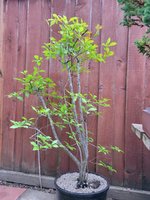Are there any progression threads on these? I'm trying to understand the best way to develop them - I know they're grown primarily for the fruit, but folks seem to let the larger ones grow lanky and live their lives in pots vs. growing out and chopping, is that accurate?
I know root cuttings can be well used for shohin in particular and I have a few of those going, but I also have some younger ones and I'm trying to figure out what milestones I'm working for (i.e. how to get lower budding for branches, how to treat them since they don't thicken quickly).
No fruits yet, but possibly next year unless development tactics require I cut off the parts that require it.
Also - my understanding is that there is a hormone that allows non-dwarf (kinzu kumquat is dwarf, for example) fruiting species to develop fruits and ramification closer on their structure in vs. just tips of branches - I heard this related to beautyberry in particular, from someone who would know. Has anyone else heard of this? I should be getting info on this at some point and will be sure to flag if not.












